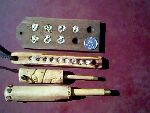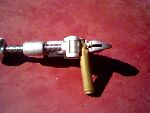
| | Top to bottom:
DGW .32 caliber loading block
Homemade .32 caliber loading block
Homemade .32 caliber bullet starter
Homemade .50 caliber bullet starter |
|
I discovered a design flaw in the Dixie Gun Works .32 caliber traditional loading block about 10 seconds after I used it for the first time. While trying to keep one eye on the limb-jumping squirrel I had just shot at and missed and my other eye on the hand trying to position the loading block over the muzzle of my rifle, I learned that it takes both eyes to correctly position the loading block. You must align it forward and backwards and from side to side—in 2 directions.
A few days later I spied a pile of cedar branches I had cached several months earlier. They were dry and ready for making into something useful. But what? Ahhhhh, I decided, a better designed loading block!
I hacked off about a 7" section of a limb about 1 1/8" in diameter. Using a Dremel® tool with a little sanding drum, I flattened the top of the section, then the bottom, leaving the section about 1/2" thick across the flats. Then I de-barked the two rounded sides.
I then penciled 10 Xs exactly 1/2" apart along a flattened side. Using a drill slightly too small, I drilled the 10 holes, then carefully reamed them with a rattail file until a patched round ball fit snugly inside. If I had reamed one of them too large, I would have painted the inside of the hole with epoxy, let it dry, then reamed again. All 10 holes the proper size, I used a cone-shaped grinding wheel and slightly beveled the edge of each hole, top and bottom. I rounded the ends of the section, drilled a lanyard hole, and a section of a dead cedar limb became a .32 caliber loading block.
 As you can see from the photo on the right, it self-aligns forwards and backwards. I can start a ball and keep an eye on an escaping squirrel. Notice that the loading block is not straight. The flats aren't even perfectly flat. But it works like a charm and looks very cool, at least to me.
As you can see from the photo on the right, it self-aligns forwards and backwards. I can start a ball and keep an eye on an escaping squirrel. Notice that the loading block is not straight. The flats aren't even perfectly flat. But it works like a charm and looks very cool, at least to me.
The ball starter that came with the Dixie Gun Works loading block worked just fine, but now that I had such a cool-looking homemade loading block I needed a cool-looking homemade bullet starter. Off came another section of the same cedar limb.
 I sanded it, then drilled one end to fit a smaller in diameter and sanded section of a cedar limb, then epoxied the smaller section in place. The epoxy dry, I drilled an exact fit, tiny pilot hole, filled it with epoxy, and inserted a 5/8" X 18 solid brass escutcheon pin. (Box of 100 = $1.69 at Ace Hardware.) Only that pin goes into and through the center limb section. The other brass pins you see in the closeup photo are for decoration. I cut them off about 1/4" in length and inserted them in epoxy filled pilot holes.
I sanded it, then drilled one end to fit a smaller in diameter and sanded section of a cedar limb, then epoxied the smaller section in place. The epoxy dry, I drilled an exact fit, tiny pilot hole, filled it with epoxy, and inserted a 5/8" X 18 solid brass escutcheon pin. (Box of 100 = $1.69 at Ace Hardware.) Only that pin goes into and through the center limb section. The other brass pins you see in the closeup photo are for decoration. I cut them off about 1/4" in length and inserted them in epoxy filled pilot holes.
I needed some sort of brass ring around the bullet end of the starter in order to keep the wood from splitting. The neck of a fired .270 Winchester case fit loosely inside the muzzle of my .32 caliber rifle. Perfect. I used a tubing cutter and removed the neck from the case and epoxied it over the end of the starter. I then carved out the end of the starter to fit the contour of a round ball.

| | The tubing cutter in action. In spite of the case's odd angle, the cutter easily removed the neck. |
|
The.50 caliber starter you see in the closeup photo above was made from sections of 2 hickory limbs. The brass ring at the business end is a section of a fired 30-06 case, cut off with a tubing cutter.
To make the business end of the .50 caliber starter fit the flat, Keith-style nose of the Lee R.E.A.L. bullet I like to shoot, I carved out the end and filled it with epoxy. The starter pointed up and wedged in place, I inserted the oiled nose of a R.E.A.L. bullet into the epoxy-filled cavity, carefully positioned the bullet, then left it in position until the epoxy dried.
Notice that the handle of my .50 caliber starter is 1 1/2" longer than the handle of my .32 caliber starter. (4 1/2" vs 3".) The .32 caliber starter's handle is a little too short for my hand. Thus I made the .50 caliber starter a little longer.
To me, one of the most enjoyable aspects of muzzleloader hunting/shooting is making my own stuff. It may not look perfect, but it works and I made it with my own hands. Try it; you might like it!
|